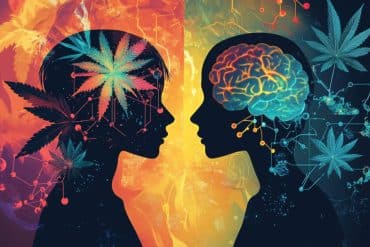Summary: A new center headed by neurobiologists at Harvard is looking to unravel some long standing mysteries of the human brain. Researchers, backed by a $10 million grant, hope to shed light on brain development, evolution and human behavior. The funding will allow researchers to use ancient DNA to track frequency of genetic changes and provide a better understanding of the nature of human adaptation.
Source: Harvard.
New center asks: What genetic changes gave us the human brain?.
How did our distinctive brains evolve? What genetic changes, coupled with natural selection, gave us language? What allowed modern humans to form complex societies, pursue science, create art?
While we have some understanding of the genes that differentiate us from other primates, that knowledge cannot fully explain human brain evolution. But with a $10 million grant to some of Boston’s most highly evolved minds in genetics, genomics, neuroscience and human evolution, some answers may emerge in the coming years.
The Seattle-based Paul G. Allen Frontiers Group has announced the creation of an Allen Discovery Center for Human Brain Evolution at Boston Children’s Hospital and Harvard Medical School. It will be led by Christopher A. Walsh, the Bullard Professor of Pediatrics and Neurology at HMS and chief of the Division of Genetics and Genomics at Boston Children’s. Michael Greenberg, the Nathan Marsh Pusey Professor of Neurobiology and head of the Department of Neurobiology at HMS, and David Reich, professor of genetics at HMS, will co-lead the center.
“Unraveling the mysteries of the human brain will propel our understanding of brain development, brain evolution and human behavior,” said George Q. Daley, dean of HMS. “It also will help us understand what makes us unique as a species.
“The research conducted by these three remarkable scientists spans the gamut from molecule to organism to system and underscores the cross-pollination among basic, translational and clinical discovery as well as across neurobiology, genetics, evolutionary biology and neurology,” Daley said.
The center’s agenda is a bold one: to catalogue the key genes required for human brain evolution, to analyze their roles in human behavior and cognition and to study their functions to discover evolutionary mechanisms.
“To understand when and how our modern brains evolved, we need to take a multi-pronged approach that will reflect how evolution works in nature and identify how experience and environment affect the genes that gave rise to modern human behavior,” Walsh said.
“The launch of this center is a wonderful opportunity for three laboratories that have been working independently to come together and study the genetic, molecular and evolutionary forces that have given rise to the spectacular capacities of the human brain,” said Greenberg.
The funding “will allow us to use ancient DNA analysis to track changes in the frequency of genetic mutations over time, which will in turn illuminate our understanding of the nature of human adaptation,” added Reich.
An evolving understanding
We already know some basics of human brain evolution. First came the enlargement of the primate brain, culminating perhaps 2 million years ago with the emergence of our genus, Homo, and the use of crude stone tools and fire. Next came a tripling of brain size during the 500,000 years before Homo sapiens arose. Finally, just over 50,000 years ago, there was a great leap forward in human behavior, with archaeological evidence of more efficient manufacturing of stone tools and a rich aesthetic and spiritual life.
What transpired genetically? Prior research has taken a piecemeal approach to occasional genes that have different structures in humans versus non-humans. For example, Walsh’s lab has identified several genes that regulate cerebral cortical size and patterning, some of them through the study of brain abnormalities. The lab recently found a gene involved in brain folding—thanks to a brain malformation called polymicrogyria—that may have enhanced our language ability.

But such findings only scratch the surface of the cognitive, behavioral and cultural strides humans have made over the past 50,000 years. That’s a blink of the eye in evolutionary terms. What enabled us to invent money, develop agriculture, build factories, write symphonies, tell jokes?
Rosetta Stone(s) to decode brain evolution
The researchers think not one but multiple mechanisms of evolution helped form the modern human brain. Such mechanisms include:
- Gene addition, duplication or deletion
- Alteration in the protein-coding sequence of genes to create new or modified biochemical functions
- Changes in noncoding DNA sequences altering patterns of gene expression, allowing an existing gene to be “re-purposed”
- Polygenic changes (changes in many genes working together)
Accordingly, the center’s research methods will include, in varying combinations:
- Sequencing of ancient DNA recovered from bones and teeth
- Genomic studies of large populations to identify regions that correlate with human traits
- Genetic studies to test functional effects of mutations in the evolutionarily important genomic sequences
- Functional studies in neurons to determine the roles of these evolutionarily important sequences in the brain
No genetic stone unturned
All these approaches will be supported by powerful computational data analysis—reaching across genomes, across populations, across hundreds of thousands of years.
The project leaders summed it up: “This group will provide the most rigorous possible examination of how, when and where the unique features of the amazing human brain came about.”
The $10 million grant will be distributed over four years, with the potential for $30 million over eight years.
Source: Nancy Fliesler – Harvard
Image Source: NeuroscienceNews.com image is adapted from the Harvard news release.
[cbtabs][cbtab title=”MLA”]Harvard “Decoding Brain Evolution.” NeuroscienceNews. NeuroscienceNews, 10 July 2017.
<https://neurosciencenews.com/genetics-brain-evolution-7053/>.[/cbtab][cbtab title=”APA”]Harvard (2017, July 10). Decoding Brain Evolution. NeuroscienceNew. Retrieved July 10, 2017 from https://neurosciencenews.com/genetics-brain-evolution-7053/[/cbtab][cbtab title=”Chicago”]Harvard “Decoding Brain Evolution.” https://neurosciencenews.com/genetics-brain-evolution-7053/ (accessed July 10, 2017).[/cbtab][/cbtabs]






